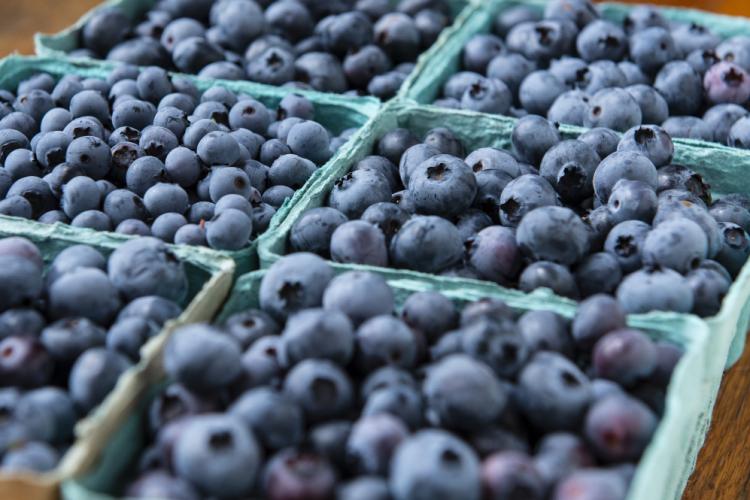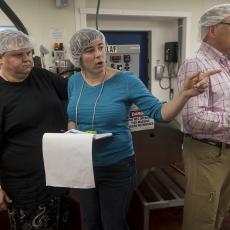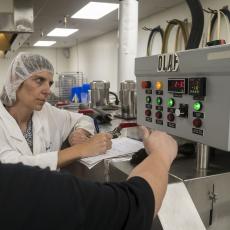In Our Spotlight
Got Local Fruit and Veggies in Your Freezer?
How far does a blueberry travel from a local bush to your home freezer? Normally not a very big journey. But finding out whether or not those same blueberries can be frozen and sold commercially in your local market is proving to be a long a winding road.
Northern highbush, lowbush, wild, huckleberries, Misty, Sharpblue….they go by many names but no matter what you call them, blueberries plucked fresh off the bush are a mighty tasty snack. Massachusetts is nearly swimming in fresh blueberries every summer. In recent years, town festivals have popped up to honor this nutritious crop, many of them established on pick-your-own farms. But what is a Baystate berry aficionado to do in the dead of winter to feed their craving for this scrumptious navy blue fruit?
To find out, an expert team at the University of Massachusetts Amherst came together to use an integrated research-extension program to determine whether or not a new market for growers of local frozen blueberries exists. Amanda Kinchla, extension associate professor and food scientist along with Jill Fitzsimmons, research assistant professor in resource economics and Daniel Lass, professor emeritus resource economics, received a two-year grant from the Northeast Sustainable Agriculture Research and Education (NESARE) program of USDA for $199,000 to investigate possibilities. They invited a third essential collaborator to join the team: the Western Massachusetts Food Processing Center (WMFPC), a program of the Franklin County Community Development Corporation (FCCDC), located in Greenfield, Mass.
So, you may ask, “What’s the big deal? I buy frozen blueberries all the time.” Here is the difference: what if you had the choice to consume local berries from small, local (not corporate) grower? How much would you pay to buy a package of local blueberries that supported a local farm?
Surprisingly, no one has figured out the economics and food science of marketing local frozen food in New England. Here is the question this team aims to answer: Is it feasible, or profitable, to grow and freeze packages of frozen fruits and vegetables in New England? The NESARE-funded collaborators are researching both frozen spinach and blueberries to find answers.
Not only are they conducting research, they are also playing the traditional role of Extension as they assist growers who often face challenges of understanding economic and community development. If a grower decides to create a business model for their farm, they can rely on this research team who are already up to their elbows in frozen fruit, researching and documenting the many steps necessary for a Massachusetts grower to embark on a frozen produce business. This is Extension at its best, taking the guesswork out of an idea and handing over big details: process optimization for quality, developing and implementing a food safety management plan, pricing and marketing considerations, production costs, and other objectives that will save a grower years of time and money.
Market Viability
Jill Fitzsimmons explains that there are many variables to determine whether or not a food product is a good candidate for the frozen food market. And when it is a consumer product, there are also specific considerations to take into account. These matters are at the very heart of her research.
Fitzsimmons is assessing these key elements: What are consumer preferences for locally or regionally grown and processed blueberries? Where do consumers want to buy locally or regionally grown and processed products? How do these consumer preferences affect the retailer, processor and farmer? Are consumers willing to pay for these products and how should they be packaged and priced? How much does it cost to provide consumers with a product that meets all of their criteria? What are the processing costs for locally or regionally grown and processed products? Are farmers willing and able to provide berries to the processor? Who are the consumers?
 Putting Puzzle Pieces Into Place
Putting Puzzle Pieces Into Place
Meanwhile, Fitzsimmons is also documenting how the overall supply chain works and then determining the economic viability of selling local frozen food. With clearly defined, if sometimes overlapping tasks, she appreciates the cross-disciplinary nature of this project. Fitzsimmons says, “It is not too often that collaborations such as ours take place across academia and the private sector. But it is important to have informed people from different disciplines at the table for a task as big as this one.”
The critical question: How much will consumers will pay for local/regional frozen products? Many factors are critical to provide an accurate assessment of the viability for selling local frozen foods.
Constraints Dictate Choices
There is a delicate dance to balance the knowledge that all team members bring to the table. Kinchla and Buxton brought their knowledge of what it takes to process a high-quality, safe consumer product. Fitzsimmons and Lass brought their knowledge regarding how to understand consumer demand and assess production costs. Each set of knowledge is different, but to make a successful end product, the team has to step outside their boxes and incorporate one another’s knowledge. For example, packaging is a component that each side sees from a different angle. Consumers may prefer a certain kind of package, but the first job of a package is to preserve the food inside it. After a collaborative effort from the whole team, Fitzsimmons has begun to put all of the pieces together for market consumer opportunities and started number-crunching in two categories: developing and analyzing how much it costs to produce a safe, high-quality product as determined by the food science and production team, and consumer demand.
The first step was to choose the fruit and vegetable to be considered for this project. The team examined which foods have the potential and volume to be grown in a western Massachusetts climate at large numbers. (The WMFPC is located in the northwest area of the state.) They also assessed the capacity of the commercial kitchen at the WMFPC. All available equipment and storage areas (pre and post-processing) were catalogued. Packaging needs and best size containers were evaluated.
Since western Massachusetts is chock-full of corn in the summer, one might imagine it would make an excellent crop to freeze in large quantities. But not so fast. How long does it take you to shuck a few dozen ears, pull off the silk, get the corn off the cob and then find a place to dispose of cobs when your compost bin is full? Now multiply that hundreds of times. Processing acres of corn with massive amounts of labor involved quickly becomes expensive. How about green beans? Another labor intensive endeavor since they need to conform to the same length, be lined up and all ends snipped off. Plus, they have a serious mold problem. Peas need to be de-podded, and the list of potential complications just grows.
The team concluded blueberries were a promising fruit choice since they require little to no preparation making it a low production risk. However, their vegetable choice, spinach, is turning out to be expensive and time-consuming.
To begin assessing consumer demand, a survey was completed. Individuals and groups were asked to provide feedback on these topics:
- Price-How much would you pay for a 12-ounce bag of local frozen blueberries?
- Does it matter to you where they are grown? [local, Northeast, USA, no information]
- Does it matter to you where they are frozen? [local, Northeast, USA, no information]
- Where will a consumer buy the product? [direct at farm stands, frozen, supermarket, big box store]
- Branding/marketing: Does packaging influence your choice?
Compiling these answers shaped first steps of the research.
 Frozen in Time
Frozen in Time
John Waite, Executive Director, Franklin County Community Development Corporation (FCCDC); Liz Buxton, Western Massachusetts Food Processing Center (WMFPC) Operations Director; and Kate Venne, Food Business Coordinator
The WMFPC in Greenfield, Mass. is as busy as a spring beehive. During the summer months, their 1,000 square foot freezer is packed with 86 pallets of broccoli, squash, peppers and strawberries. Currently, during the winter, the WMFPC has a line of six frozen products.
Interspersed with freezing vegetables, a polar opposite process takes place in the next room. Large hot kettles simmer with local fruit to generate jars of jams and jellies while vats of tomato salsa are processed and packaged in-house. Several small businesses prepare fruits and veggies at the WMFPC for their own markets.
Buxton and Venne are part of the team to research whether or not it makes economic sense to market frozen blueberries and spinach. They come armed with financial statistics on cost per unit (labor, facility, ingredients) and other relevant data.
WMFPC has a dependable history of coordinating product sales to regional stores, schools, a jail and other commercial outlets. This experience makes them an ideal partner to explore the viability for local frozen foods to individual (not large retail) consumers.
Do you remember the days when frozen spinach only came in a 6” hard block? Prying off half of it required partial thawing and a risk of cutting yourself as you chipped off a small portion with a sharp knife. Thankfully, technology has greatly improved with the advent of Individually Quick-Frozen (IQF) food. Now, each piece of produce and every berry is “flash” frozen at a very low temperature using liquid nitrogen. After three trials, it was determined that blueberries could be processed at -120 for 2 minutes and 30 seconds as the optimal processing condition. At that quick cold temp, the cell wall of the berry does not have time to break down. Delicious berries that freeze well, hold their shape and thaw similarly to the day they were picked produce a much better end-product. Using IQF, the thawed quality is more similar to a fresh berry than to a comparable berry frozen using a slow freezing method.
With IQF method, it takes just one hour to freeze 500 pounds of blueberries! Blueberries can be stored at the WMFPC with an 18-month shelf life at -5 F degrees. A home freezer is not that cold, so suitable time to be spent in your freezer is much shorter.
Next Steps
Selling frozen food is a multi-layered process. So it is no surprise that after 12 months of research, more questions are bubbling to the surface. The team is gathering a list of issues that go beyond the scope of this project which ends in late 2020. For example:
When a new food product stream is started, the challenge of finding more of that food source may require diverting it from an established destination. Should growers plant more acreage in low or high bush berries to invest in a new market, thus capturing a new business opportunity?
What is the right business model? What will retail distribution look like? Will growers freeze their own berries and sell them at local farm stands? Could a grower contract with a processor and then take their frozen product back to their farm? If a grower decides to sell to larger grocery stores, how will they learn how to break into a bigger retail distribution scheme? Could the processor buy the product for a grower and distribute it themselves?
It is hoped that a future grant award will help answer these questions.
 How many blueberry farms are in Massachusetts?
How many blueberry farms are in Massachusetts?
Most people think of highbush blueberries when they think of picking them. Many don't know that Massachusetts also has significant acreage planted in lowbush (wild) blueberries. According to the 2017 Massachusetts Agricultural Census, there are 356 farms that grow blueberries on 900 acres. To be clear, two-thirds of the Baystate’s berries come from highbush berries. Lowbush berries are grown on one-third of the land and most of them come from just three to four farms. One challenge already identified by the team is that the majority of blueberries grown in Massachusetts are already sold at pick-your-own farms or at local seasonal farm stands. There are not a lot left over to freeze and sell later. Could planting and growing more berries be seen as a possible growth opportunity for berry farmers? More food planted locally seems like a great step forward.
Factoids and Helpful Blueberry Links
The blueberry is one of the few fruits native to North America. Can you guess the other? It is its ruby red cousin, the cranberry. Blueberries can grow on slopes, in bogs and forests or on high or low bushes. No matter what you call them: huckleberries, bilberries, blues or whortleberries, there is nothing quite like popping these luscious little berries in your mouth on a hot summer day.
Children’s literature embraces the blueberry with classics such as Robert McCloskey’s Blueberries for Sal (“kaplink, kuplank, kuplunk” the sound as they fall into Sal’s tin pail). In Mark Twain’s Adventures of Huckleberry Finn, Huck’s character ‘had as good a heart as ever any boy had.’ The range of slang meanings of huckleberry in the 19th century was broad, also referring to significant persons or nice persons. With that line of reasoning, a blueberry, so good and so nice, is a real huckleberry. Eat up, yum.
According to Massachusetts Master Gardeners, blueberries also have antioxidants and play a role in anti-aging because they subdue free radicals that cause cell abnormality. For how to grow your own, click here [embed: http://massmastergardeners.org/back-yard-blueberries/]
For information and tips on how to grow your own, see:
The Massachusetts Cultivated Blueberry Growers Association



